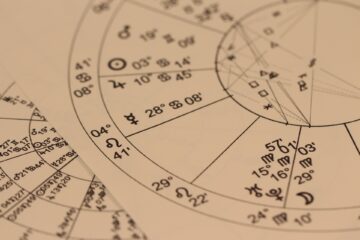The twelve houses in Vedic astrology are the working architecture of a chart. Each 30° division describes an arena of life where planetary promises unfold. Learn the planets and signs for vocabulary; the houses tell you where it happens.
Understanding the Twelve Houses (Bhavas) in Vedic Astrology
We read nine grahas (Sun, Moon, Mars, Mercury, Jupiter, Venus, Saturn, Rāhu, Ketu). Rāhu and Ketu are nodes, yet act like planets and sit 180° apart. When a planet rules two signs, its mūlatrikoṇa (MK) house carries more functional weight. Always synthesize: house = arena, planet = actor, sign = manner of acting.
House-by-House Practical Meanings
1st House — Self & Vitality
Body, appearance, health baseline, temperament, the way life begins moving. Head, brain, skin. The 1st colors every transit and timing judgment.
2nd House — Wealth & Speech
Savings, movable assets, family environment, voice and speech, mouth/tongue, basic education, vision. Material security and stored value.
3rd House — Courage & Communication
Younger siblings, initiative, writing/media/internet, short travel, hands/arms, skills and hobbies. Where effort becomes momentum.
4th House — Home & Emotional Security
Mother, homeland, real estate, private vehicles, chest/lungs, schooling up to higher-secondary. Peace of mind and the inner room of safety.
5th House — Creativity & Children
Procreation, romance, memory, speculative intelligence, fame via creativity or intellect, stomach/heart area. Risk-taking and recognition.
6th House — Health, Service & Enemies
Illness (especially acute), daily work and service, litigation, debts, small persistent troubles, hygiene, animals, surgery. Where we learn persistence.
7th House — Marriage & Partnerships
Spouse, contracts, business alliances, open opponents, sexuality, legal ties; frequent indicator for foreign residence. One-to-one public relations.
8th House — Transformation & Secrets
Sudden events, crisis, inheritance, shared resources, occult, chronic disease, deep psychological change. Endings that become rebirth.
9th House — Faith & Fortune
Father/guru, higher learning, religion/philosophy, long journeys, publishing, merit and long-run luck. The teacher principle.
10th House — Career & Public Life
Work, status, authority, karma made visible, executive capacity and reputation. How the world witnesses your actions.
11th House — Gains & Alliances
Income after effort, networks, elder siblings, fulfillment of desires, recoveries, social recognition. The ecosystem of rewards.
12th House — Loss, Liberation & Hidden Realms
Expenditure, isolation, hospitals/retreats, sleep, distant places, hidden enemies, spiritual surrender and moksha themes.
Core Structural Principles of House Interpretation
- Bhavat Bhavam: houses echo through each other (e.g., 3rd from 3rd = 5th).
- Kendra & Trikona: 1/4/7/10 are structural centers; 1/5/9 are dharmic and supportive.
- Duṣṭhānas (6/8/12): arenas of struggle/purification; read with nuance, not fear.
- Maraka Logic: 2nd and 7th can act as death-inflicting under specific, corroborated conditions; use carefully.
How to Read Houses in Practice
- Start with the house cusp & sign: sets the style/tempo of events.
- Judge the house lord: dignity, aspects, placement — who is acting and how capable.
- Assess occupants: planets in the house are active agents; check divisionals (D9 for marriage, D10 for career, etc.).
- Synthesize: sign + planet + house = living outcome; timing via daśā/transit strengthens or delays.
Important Notes & Clarifications
Which reference is primary — Lagna, Moon-lagna or Arudha-lagna?
Read Lagna first (body/health/agency), Moon-lagna second (emotional/public flow), Arudha third (public image/projection). Each view adds a useful lens.
What if a house lord is retrograde or combust?
Expect modified delivery: retrograde often internalizes or delays; combustion reduces visible strength. Still judge aspects, dispositors and daśā — a “weakened” lord can perform if supported.
How to use divisional charts with houses?
D1 shows promise; divisionals specialize it (D9 marriage/dharma, D10 profession, D3 siblings/effort, etc.). Always confirm D1 signals with the relevant divisional.
Are 6/8/12 always bad?
No. They indicate friction/purification. A capable planet there can produce resilience, service, insight and spiritual outcomes. Context decides.
Reading large clusters (Gola yoga) in one house?
The clustered house becomes a life hub, but results depend on dignity, combustion, retrogression and aspects. Verify with daśā and divisionals — never judge by the cluster alone.
Do planets “preserve” houses they occupy?
Slow planets add gravity: Saturn can steady or restrict; Jupiter can expand or overindulge. Preservation vs. stagnation depends on dignity and functional role for the ascendant.
How to discuss maraka/lifespan without alarmism?
Use maraka rules only with reliable data and multiple confirmations. Prefer discussing vulnerabilities and practical remedies over deterministic statements.
Is the 11th house always ‘good’?
It’s the house of gains and fulfillment, but desire can bring ethical trade-offs. Read the 11th as rewards that must be integrated responsibly.
Chalit shift — is it better for a lord to move forward?
Many prefer forward movement as progressive expression, but dignity/aspects/daśā outweigh this single factor. Treat it as a tiebreaker, not a verdict.
FAQ — Common Questions About Houses in Vedic Astrology
Rāśi vs. Bhava: which to prioritize when they differ?
Prioritize bhava for life events (where); use rāśi for style (how). Degree proximity and conjunctions tell you which tone dominates.
Benefic in a duṣṭhāna — should I worry?
Not by default. Benefics can heal/service (6th) or give spiritualization (12th). Judge total strength (ṣaḍbala), aspects, and timing.
When do I check divisionals during house work?
After D1 suggests a domain needing detail (marriage, career, siblings, property). Then consult the relevant divisional to confirm strength and timing.
Conclusion — Reading the Architecture
Houses are rooms where karma breathes. When you map the twelve houses in Vedic astrology to planets and signs, the chart turns from symbolism into consequence. Read the arena, evaluate the actor, listen to the tone — and the story reveals itself.
Ask your karma. Decode your chart at Much Needed Astro.



